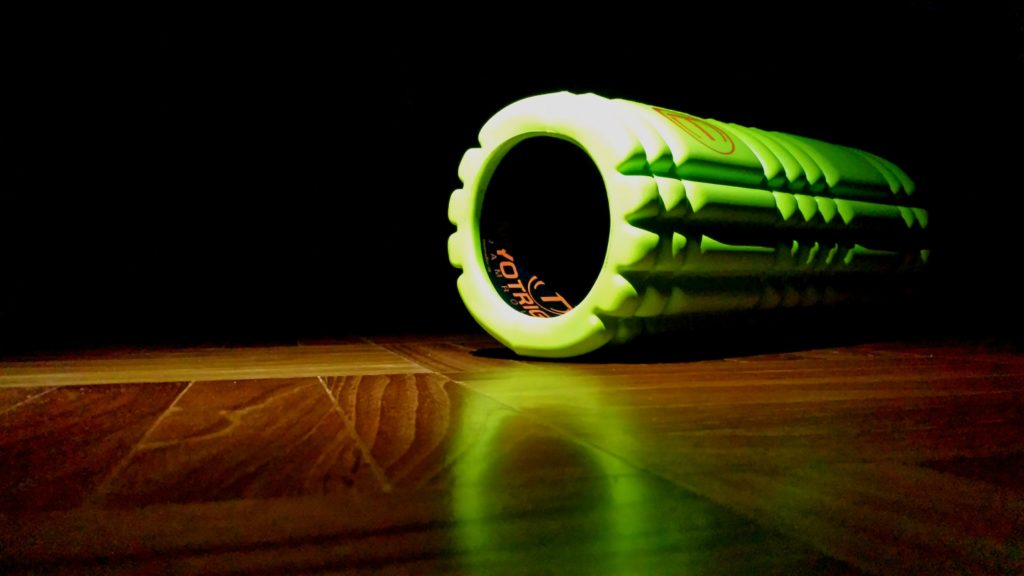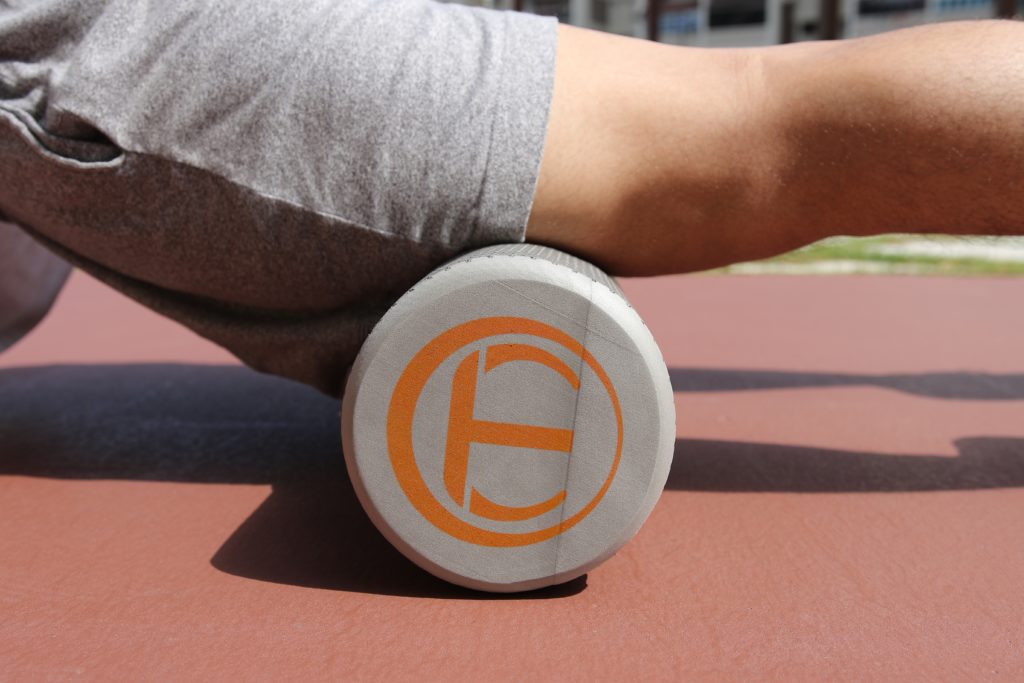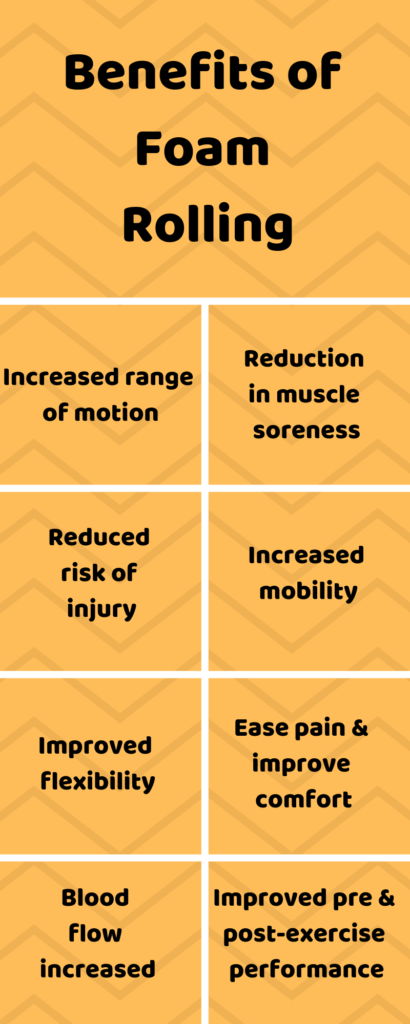Benefits of foam rolling

What is foam rolling?
Foam rolling is a type of self-myofascial release, or self massage that involves a padded cylindrical device to massage the fascia, muscles, trigger points, tendons, and skin by directly adding pressure to these areas.
What is fascia?
Put simply, fascia is one continuous layer of thick, woven covering that encapsulates our entire bodies including muscles, organs, and bones.
Think of it like a layer between all of these body parts and the skin that supports bodily functions and movements. In a comfortable state, it is soft and relaxed.
But, we are constantly stressing our bodies from sitting, working, exercising, and living.
Think of every time you’ve felt tightness, soreness, or a knot anywhere in your body. Most likely, it’s your fascia that’s become tight and restricted, thus limiting mobility and range of motion.
Enter the foam roller.
Think of foam rolling as massaging yourself. You’re using the force of gravity to roll your body along this padded cylinder, releasing all those kinks and knots, relieving soreness, and restoring mobility.
If you ever feel tight or sore, try foam rolling for a few minutes, and see how you feel. I recommend trying it before and after exercise, but also first thing in the morning. It helps to open up your blood vessels, and relax those stiff muscles. It’s a great addition to your morning routine.

Benefits of foam rolling
Scientific research has been done on the effects of foam rolling. Some of these studies find that foam rolling has some incredible benefits. These include:
- Increased range of motion
- Improved pre and post exercise performance
- Reduction in DOMS (delayed onset muscle soreness)
- Increased mobility
- Increased blood flow
- Improved flexibility
- Reduced risk of injury
- Ease pain and improve comfort.
(health benefits of foam rolling)
Breakdown of Foam Rolling Benefits
Foam rolling increases blood flow throughout your body.
It massages and relaxes your muscles, loosening them up and relieving tension, allowing blood to flow through the body more easily.
Increased blood flow allows for greater flow of oxygen and nutrients like glycogen throughout the body, which leads to other benefits like improved exercise performance and reduced risk of injury.
Increased range of motion & Improved muscle performance
In a study measuring effectiveness of foam rolling, researchers found that participants who foam rolled before exercise increased their joint range of motion immediately following rolling.
The same study found that foam rolling improved pre- and post-exercise muscle performance.
It makes sense that all of these benefits work in tandem. By increasing blood flow to your muscles and massaging away any tightness or wrinkles in your body’s fascia, you are priming your body to perform better for physical activity.
Reduction in Muscle Soreness & Stiffness – Faster Recovery
The same study also found that these participants experienced a reduction in DOMS following intense exercise. DOMS stands for delayed onset muscle soreness. Ever workout and feel yourself getting increasingly sore over the next few days? That’s DOMS.
By releasing tension in your fascia, reducing soreness, and opening up blood flow to these muscles, you are speeding the recover process in your body. Athletes utilize foam rolling to recover faster, and improve their performance.
Increases Mobility & Decreases Pain
In a survey of 685 Physical Therapy professionals, a majority claimed that self massage via foam rolling increases mobility and decreases pain in patients prescribed the procedure regularly.
Reduced Risk of Injury
These effects are immediately noticeable after foam rolling for only a short time. You’ll feel more flexible, and experience less pain. You also protect yourself from injury.
By priming and relaxing your muscles and increasing blood flow, you are going into physical activity with your body in its ideal state. Imagine going into a workout stiff as a board, and then trying that same workout again totally relaxed, loose, and with your blood flowing at a greater rate.
Improve Quality of Life of Fibromyalgia Patients
In a randomized, controlled trial done to measure the benefits of health quality of life in patients with fibromyalgia, researchers found that the application of a regular, structured self-myofascial release program can improve the health-related quality of life of people with Fibromyalgia.
If foam rolling can benefit people with chronic pain conditions, it stands to reason that it could benefit people with any type of pain, whether it be normal aches and pains, or from physical exercise.
Who is it for?
Foam rolling is for everyone. We all suffer from muscle soreness, tightness, knots, or body aches occasionally. Foam rolling relieves all of these symptoms.
Athletes can especially benefit from rolling as they suffer from these symptoms often. Anyone with chronic pain may benefit as well as fibromyalgia patients.
Precautions (who it is not for)
People suffering from any of the following ailments may want to consult a doctor before trying foam rolling, as more factors are at play in these conditions:
Hypertension, osteopenia, pregnancy, diabetes, varicose veins, numbness, pressure sensitivity, recent injury or surgery, young children, older adults, scoliosis, and others.
Safety
If experiencing severe pain, consult a doctor before trying foam rolling. Same goes for any pain experienced during the rolling process. Try to avoid the area between middle and lower back. Some report discomfort when rolling over this area.
Scientific studies still emerging
While there have been some studies done on the effects of foam rolling and self-myofascial release, research into the area is still emerging, and more scientific literature is needed to say with certainty all the health benefits and side effects.
How do you do it?
In order to effectively self-myofascial massage, you should target specific muscle groups and roll them with a foam roller individually. Place the foam roller underneath a leg or upper back, and roll back and forth. Continue on other muscle groups.
You’ll feel the process working pretty quickly. PT professionals recommend daily rolling of 30 seconds – 2 minutes per muscle group.
Your foam rolling plan
To start experiencing some of the wonderful benefits of foam rolling, start rolling before and after exercise. Start with large muscle groups like your back and legs, and you can expand from there.
Try rolling each muscle group for 30-90 seconds just before, and immediately following your exercise routine.
You’ll noticeably feel more flexible, have better performance, and won’t feel nearly as sore going forward.
To truly take care of your body, and get all you can from your workouts, try adding the sauna or steam room to your routine. The health benefits will amaze you.
